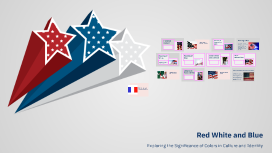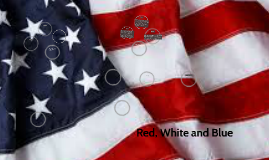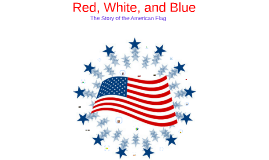Red White and Blue
Transcript: Origins of the Colors Symbolism in Different Cultures Historical Events Associated Adoption in National Flags Many countries have adopted red, white, and blue in their flags, most notably the United States, France, and the United Kingdom. These colors often reflect historical struggles, revolutions, or unifying movements, embodying the nations' core values and identity. Red, white, and blue have origins rooted in ancient civilizations. Red often symbolizes bravery and strength, white represents purity and peace, while blue signifies loyalty and justice. These meanings have evolved through centuries, shaping cultural identities across the globe. These colors have diverse meanings across cultures. In some societies, red denotes love and passion, while in others, it may represent communism. Blue may symbolize calmness or divinity, whereas white can represent mourning or peace, demonstrating cultural variances in perception. The colors red, white, and blue are tied to significant historical events, such as the American Revolution and the French Revolution. They represent the fight for sovereignty, freedom, and the emergence of democratic ideologies that continue to influence nations today. Emotional Responses to Colors Influence on Patriotism Colors in Propaganda Colors and National Identity Colors can trigger varied emotional responses; for instance, red often conveys passion or anger, while blue may evoke calmness. Studies show that colors significantly impact mood and decision-making, influencing perceptions of national pride. Throughout history, colors have been manipulated in propaganda to influence public perception and behavior. Notably, bright colors are often used in campaigns to elicit positive emotions and convey strong messages. Colors can significantly heighten feelings of patriotism; for instance, during national celebrations, people often wear colors representing their flag. This collective display reinforces community bonds and national pride. The colors of national flags serve as a symbol of identity and unity. For example, red, white, and blue are frequently associated with democracy and freedom, reinforcing citizens' connection to their nation. Representation in National Sports Incorporation in Fashion and Art Colors in Global Events Themed Celebrations Red, white, and blue have transcended traditional symbolism to influence modern fashion and art, representing chic styles and cultural statements. Designers often incorporate these colors to create pieces that resonate with national pride and identity. National teams often showcase red, white, and blue colors during international competitions, reinforcing national identity. Iconic events like the Olympics see athletes donning these colors to unite fans and symbolize national pride. Global events such as Independence Day and Bastille Day prominently feature red, white, and blue in celebrations, parades, and fireworks. These colors evoke a sense of unity and collective national pride among citizens and spectators alike. Events like Fourth of July and Memorial Day in the U.S. feature themed celebrations utilizing red, white, and blue. Decorations, clothing, and festivities revolve around these colors, promoting a strong sense of community and patriotism during such occasions. Globalization and National Colors Changing Interpretations Embracing Diversity through Colors Color Trends in Nationalism Globalization influences the perception of national colors, as intercultural exchanges result in new meanings and adaptations. This can be seen in the way these colors are used in multicultural societies, creating a diverse symbolism. Emerging trends show a blending of national colors with regional identities. This phenomenon highlights how modern nationalism can both unite and divide as individuals express pride through colors that transcend traditional interpretations. National colors adapt to reflect societal values and movements. For instance, the interpretation of red, white, and blue has shifted in response to social justice campaigns, connecting the colors to themes of equity and representation in contemporary discourse. The colors red, white, and blue can serve as a unifying force, advocating for inclusivity and diversity. Initiatives that reinterpret these colors aim to foster a sense of community while honoring various identities within national frameworks. Red White and Blue Exploring the Significance of National Colors

















